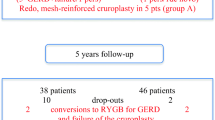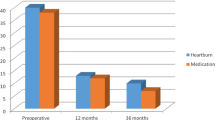Abstract
Background
The prevalence of gastroesophageal reflux disease (GERD) and/or hiatal hernia (HH) is significantly increased in morbidly obese patients. Laparoscopic bariatric procedures such as gastric banding (LGB) and Roux-en-Y gastric bypass have been shown to improve both obesity and reflux symptoms. The aim of this paper is to evaluate the effectiveness of laparoscopic sleeve gastrectomy (LSG) and hiatal hernia repair (HHR) for the treatment of obesity complicated by HH.
Methods
From October 2008, six patients underwent HHR in addition to LSG. Clinical outcomes have been evaluated in terms of GERD symptoms improvement or resolution, interruption of antireflux medication, and X-ray evidence of HH recurrence.
Results
Symptomatic HH was diagnosed preoperatively in four patients. In two additional patients, HH was asymptomatic and it was diagnosed intraoperatively. Prosthetic reinforcement of crural closure was performed in two symptomatic cases with a HH >5 cm. Mortality was nil and no complications occurred. After a mean follow-up of 4 months, GERD symptoms resolution occurred in three patients, while the other patient reported an improvement of reflux. Body mass index had fallen from 43.4 to 36.2 kg/m2. A small recurrence in the patient with persistence of reflux symptoms has been radiologically reported.
Conclusions
Laparoscopic crural closure in addition to LSG could represent a valuable option for the synchronous management of morbid obesity and HH, providing good outcomes in terms of weight loss and GERD symptoms control.
Similar content being viewed by others
References
Anand G, Katz PO. Gastroesophageal reflux disease and obesity. Rev Gastroenterol Disorder. 2008;8(4):233–9.
Wilson LJ, Ma W, Hirschowitz BI. Association of obesity with hiatal hernia and esophagitis. Am J Gastroenterol. 1999;94:2840–4.
Hagen J, Deitel M, Khanna RK, et al. Gastroesophageal reflux in the massively obese. Int Surg. 1987;72:1–3.
Lundell L, Ruth M, Sandberg N, et al. Does massive obesity promote abnormal gastroesophageal reflux? Dig Dis Sci. 1995;40:1632–5.
Frigg A, Peterli R, Zynamon A, et al. Radiological and endoscopic evauation for laparoscopic adjustable gastric banding:preoperative and follow up. Obes Surg. 2001;11:594–9.
Ovrebo KK, Hatlebakk JG, Viste A, et al. Gastroesophageal reflux in morbidly obese patients treated with gastric banding or vertical banded gastroplasty. Ann Surg. 1998;228:51–8.
Granderath FA, Carlson MA, Champion JK, et al. Prosthetic closure of the esophageal hiatal hernia repair and laparoscopic antireflux surgery. Surg Endosc. 2006;20:367–79.
Granderath FA, Kamolz T. Quality of life, surgical outcome, and patients’ satisfaction three years after laparoscopic Nissen fundoplication. World J Surg. 2002;26:1234–8.
Carlson MA, Frantzides CT. Complications and results of primary minimally invasive antireflux procedures: a review of 10, 735 reported cases. J Am Coll Surg. 2001;193:428–37.
Basso N, De Leo A, Genco A, et al. 360° laparoscopic fundoplication with tension-free hiatoplasty in the treatment of symptomatic gastroesophageal reflux disease. Surg Endosc. 2000;14:164–9.
Soricelli E, Basso N, Genco A, et al. Long-term results of hiatal hernia mesh repair and antireflux laparoscopic surgery. Surg Endosc 2009 [Epub ahead of print].
Frantzides CT, Madan AK, Carlson MA, et al. A prospective, randomized trial of laparoscopic polytetraflouroethylene (PTFE) patch repair vs simple cruroplasty for large hiatal hernia. Arch Surg. 2002;137:649–53.
Granderath FA, Schweiger UM, Kamolz T, et al. Laparoscopic Nissen fundoplication with prosthetic hiatal closure reduces postoperative intrathoracic wrap herniation: preliminary results of a prospective randomized functional and clinical study. Arch Surg. 2005;140:40–8.
Keidar A, Szold A. Laparoscopic repair of paraesophagealhernia with selective use of mesh. Surg Laparosc Endosc. 2003;13:149–54.
Dally E, Falk GL. Teflon pledget reinforced fundoplication causes symptomatic gastric and esophageal lumenal penetration. Am J Surg. 2004;187:226–9.
Targarona EM, Bendaham G, Balague C, et al. Mesh in the hiatus. Arch Surg. 2004;139:1286–96.
Perez AR, Moncure AC, Rattner DW. Obesity is a major cause of failure for both abdominal and transthoracic antireflux operations. Gastroenterology. 1999;116:A1343.
Perez AR, Moncure AC, Rattner DW. Obesity adversely affects the outcome of antireflux operations. Surg Endosc. 2001;15:986–9.
Fraser J, Watson DI, O’Boyle CJ, et al. Obesity and its effect on outcome of laparoscopic Nissen fundoplication. Dis Esoph. 2001;14:50–3.
Gulkarov I, Wetterau M, Ren CJ, et al. Hiatal hernia repair at the initial laparoscopic adjustable gastric band operation reduces the need for reoperation. Surg Endosc. 2008;22:1035–41.
Angrisani L, Iovino P, Lorenzo M, et al. Treatment of morbid obesity and gastroesophageal reflux with hiatal hernia by lap-band. Obes Surg. 1999;9:396–8.
Frezza EE, Barton A, Watchtel MS. Crural repair permits morbidly obese patients with not large hiatal hernia to choose laparoscopic adjustable banding as a bariatric surgical treatment. Obes Surg. 2008;18:583–8.
Landen S. Simultaneous paraesophageal hernia repair and gastric banding. Obes Surg. 2005;15:435–8.
Dolan K, Finch R, Fielding G. Laparoscopic gastric banding and crural repair in the obese patient with a hiatal hernia. Obes Surg. 2003;13:772–5.
Perry Y, Courcoulas A, Fernando HC, et al. Laparoscopic Roux-en-Y gastric bypass for recalcitrant gastroesophageal reflux disease in morbidly obese patients. JSLS. 2004;8:19–23.
Salvador-Sanchis JL, Martinez-Ramos D, Herfarth A, et al. Treatment of morbid obesity and hiatal paraesophageal hernia by laparoscopic Roux-en-Y gastric bypass. Obes Surg 2008 [Epub ahead of print].
Frezza EE, Ikramuddin S, Gourash TR, et al. Symptomatic improvement in gastroesophageal reflux disease (GERD) following laparoscopic Roux-en-Y gastric bypass. Surg Endosc. 2002;16:1027–31.
Patterson EJ, Davis DG, Khanjanchee Y, et al. Comparison of objective outcomes following laparoscopic Nissen fundoplication vs laparoscopic gastric bypass in the morbidly obese with heartburn. Surg Endosc. 2003;17:1561–5.
Zainabadi K, Courcoulas AP, Awais O, et al. Laparoscopic revision of Nissen fundoplication to Roux-en-Y gastric bypass in morbidly obese patients. Surg Endosc. 2008;22:2737–40.
Raftopoulos I, Awais O, Courcoulas AP, et al. Laparoscopic gastric bypass after antireflux surgery for the treatment of gastroesophageal reflux in morbidly obese patients: initial experience. Obes Surg. 2004;14:1373–80.
Cuenca-Abente F, Parra JD, Brant K, et al. Laparoscopic sleeve gastrectomy: an alternative for recurrent paraesophageal hernias in obese patients. JSLS. 2006;10:86–9.
Bernante P, Breda C, Zangrandi F, et al. Emergency sleeve gastrectomy as rescue treatment for acute gastric necrosis due to type II paraesophageal hernia in obese woman with gastric banding. Obes Surg. 2008;18:737–41.
Mercer CD, Wren SF, DaCosta LR, et al. Lower esophageal sphincter pressure and gastroesophageal pressure gradients in excessively obese patients. J Med. 1987;18:135–46.
Greenstein RJ, Nissan A, Jaffin B. Esophageal anatomy and function in laparoscopic gastric restrictive bariatric surgery: implications for patient selection. Obes Surg. 1998;8:199–206.
Casella G, Soricelli E, Rizzello M, et al. Non surgical treatment of staple line leaks after laparoscopic sleeve gastrectomy. Obes Surg. 2009;19(7):821–6.
Nocca D, Krawczykowsky D, Bomans B, et al. A prospective multicenter study of 163 sleeve gastrectomies: results at 1 and 2 years. Obes Surg. 2008;18:560–5.
Himpens J, Dapri D, Cadière GB. A prospective randomized study between laparoscopic gastric banding and laparoscopic isolated sleeve gastrectomy: results after 1 and 3 years. Obes Surg. 2006;16:1450–6.
Hamoui N, Anthone GJ, Kaufman HS, et al. Sleeve gastrectomy in the high-risk patient. Obes Surg. 2006;16:1445–9.
Menenakos E, Stamou KM, Albanopoulos K, et al. Laparoscopic sleeve gastrectomy performed with intent to treat morbid obesity: a prospective single-center study of 261 patients with a median follow-up of 1 year. Obes Surg 2009 [Epub ahead of print].
Arias E, Martínez PR, Szomstein S, et al. Mid-term follow-up after sleeve gastrectomy as a final approach for morbid obesity. Obes Surg. 2009;19:544–8.
Cottam D, Qureshi FG, Mattar SG, et al. Laparoscopic sleeve gastrectomy as an initial weight-loss procedure for high-risk patients with morbid obesity. Surg Endosc. 2006;20:859–63.
Lakdawala MA, Bhasker A, Mulchandani D, et al. Comparison between the results of laparoscopic sleeve gastrectomy and laparoscopic Roux-en-Y gastric bypass in the Indian population: a retrospective 1 year study. Obes Surg 2009 [Epub ahead of print].
Melissas J, Koukouraki K, Askoxylakis J, et al. Sleeve gastrectomy—a restrictive procedure? Obes Surg. 2007;17:57–62.
Author information
Authors and Affiliations
Corresponding author
Additional information
The authors have no conflict of interest.
Rights and permissions
About this article
Cite this article
Soricelli, E., Casella, G., Rizzello, M. et al. Initial Experience with Laparoscopic Crural Closure in the Management of Hiatal Hernia in Obese Patients Undergoing Sleeve Gastrectomy. OBES SURG 20, 1149–1153 (2010). https://doi.org/10.1007/s11695-009-0056-8
Received:
Accepted:
Published:
Issue Date:
DOI: https://doi.org/10.1007/s11695-009-0056-8




